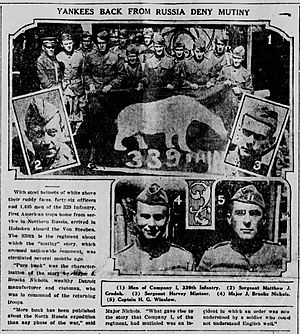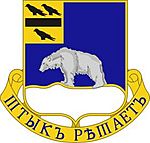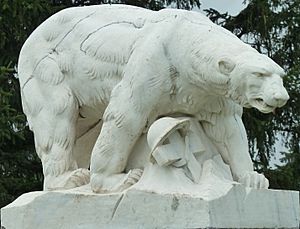American Expeditionary Force, North Russia facts for kids
Quick facts for kids 339th Regiment339th Infantry Regiment |
|
|---|---|

Men of the American Expeditionary Force return home from service in Northern Russia, arrived in Hoboken aboard the SS Von Steuben. (2) Sergeant Matthew J. Gradok. (3) Sergeant Harvey Minteer. (4) Major J. Brooks Nichols (5) Captain H. G. Winslow.
|
|
| Active | 2 August 1918 — 5 August 1919 (1 year and 3 days) |
| Country | |
| Branch | |
| Type | Infantry |
| Size | Regiment |
| Nickname(s) | Detroit's Own Polar Bears |
| Motto(s) | "We Finish With The Bayonet" |
| Engagements | Russian Civil War (Polar Bear Expedition) |
| Insignia | |
| Distinctive unit insignia |  |

The Polar Bear Expedition was a group of about 5,000 United States Army soldiers. They landed in Arkhangelsk, Russia, in September 1918. Their mission was part of a larger effort by Allied countries during the Russian Civil War. These American troops fought against the Red Army in the area until July 1919.
Contents
History of the Polar Bear Expedition

Why the Expedition Happened
U.S. President Woodrow Wilson sent the Polar Bear Expedition to Russia. This happened because Great Britain and France asked for help. They wanted American troops to join their efforts in Northern Russia.
The British and French had two main goals:
- To stop Allied war supplies in Arkhangelsk from falling into German or Bolshevik hands. These supplies were originally for the Eastern Front of World War I, which had collapsed.
- To help rescue the Czechoslovak Legion. This group of soldiers was stuck along the Trans-Siberian Railway.
On July 14, 1918, the U.S. Army's 85th Division was preparing to go to France. However, President Wilson agreed to send some American troops to Russia instead. He said they should only guard the war supplies.
General John J. Pershing then changed the orders for the 339th Infantry Regiment. This unit, along with some engineers, was sent to England. There, they were trained and given Russian weapons. They arrived in Arkhangelsk on September 4, 1918, and were placed under British command. Other Allied forces had already taken control of Arkhangelsk on August 2, 1918.
The Expedition's Journey
When British commanders arrived in Arkhangelsk, they found that the war supplies had already been moved. The Bolshevik forces had taken them up the Dvina River. So, when the American troops arrived, they were immediately used in fighting. They were meant to help rescue the Czech Legion.
The British commanders sent one group of the 339th Infantry up the Dvina River. Another group went up the Vologda Railroad. For six weeks, they fought and pushed back the Bolshevik forces.
However, these battle lines became very long, stretching for hundreds of miles. It was hard to get supplies to the soldiers. By late October 1918, they could no longer keep attacking. As winter approached, the Allies decided to defend their positions. They also realized they couldn't gather enough local anti-Bolshevik soldiers. So, they gave up on reaching the Czech Legion and prepared to hold their ground through winter.
During that winter, the Bolshevik army attacked. They caused many casualties, especially along the Vaga River. This forced the Allies to retreat quite a bit.
The American forces in North Russia suffered over 210 casualties. This included about 110 deaths from fighting. Around 30 soldiers went missing. Another 70 died from diseases, mostly the Spanish flu. An October 1919 report listed 553 casualties in total.
Coming Home
After the Allies signed an agreement to stop fighting Germany on November 11, 1918, families of the American soldiers started asking for them to come home. They wrote letters to newspapers and sent petitions to the U.S. Congress. Newspapers also called for the troops to leave Russia.
The American soldiers' spirits dropped. They knew their mission had changed. They also knew World War I was over and the port of Arkhangelsk was frozen. They asked their officers why they were still fighting in Russia. The only answer was that they had to fight to survive and avoid being pushed into the Arctic Ocean.
In early 1919, there were many rumors and some actual cases of soldiers refusing orders among the Allied forces. On February 16, 1919, President Wilson ordered the War Department to plan the withdrawal of American troops from Northern Russia. In March 1919, four American soldiers wrote a petition protesting their continued presence in Russia. They were threatened with military trials.
U.S. Army Brigadier General Wilds P. Richardson arrived in Arkhangelsk on April 17, 1919. He had orders to organize the withdrawal of American troops "as soon as possible." On May 26, 1919, British volunteer troops arrived to replace the Americans. In early June, most of the American soldiers sailed for Brest, France. From there, they went to New York City and then home. Two-thirds of them were from Michigan.
During their withdrawal, the American soldiers decided to call themselves "Polar Bears." They were allowed to wear a Polar Bear badge on their left sleeve. On July 15, 1919, the first group of Polar Bear Expedition troops returned home. They arrived in Hoboken, New Jersey, aboard the Von Steuben. The American Expeditionary Force in North Russia officially ended on August 5, 1919.
Years later, President Warren G. Harding said the expedition was a mistake. He blamed the previous government for it.
What Happened After
After the expedition, in 1920, the Polar Bear veterans started asking their state and federal governments for help. They wanted to get back the bodies of at least 125 American soldiers still buried in Russia. By that time, 112 bodies had already been returned to the United States. By 1929, research showed that 226 "polar bears" had been buried in North Russia. About 130 sets of remains were still believed to be there.
It took many years to get permission because the United States and the Soviet Union did not have official diplomatic relations. Finally, in the autumn of 1929, an expedition led by the Veterans of Foreign Wars (VFW) was successful. They found, identified, and brought back the remains of 86 U.S. soldiers. In 1934, the Soviet Union sent 14 more sets of remains to the U.S. This left about 30 U.S. soldiers still buried in North Russia.
The remains of 56 American soldiers were re-buried around the Polar Bear Memorial. This memorial was created by sculptor Leon Hermant at White Chapel Memorial Cemetery in Troy, Michigan. The ceremony took place on May 30, 1930.
Harold Gunnes, born in 1899, passed away on March 11, 2003. He was thought to be the last living American who fought in the Allied Intervention near Arkhangelsk.
See also
 In Spanish: Expedición Oso Polar para niños
In Spanish: Expedición Oso Polar para niños

